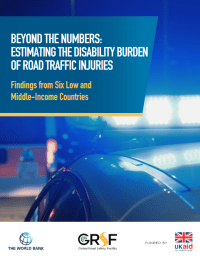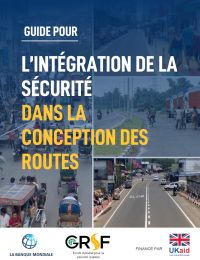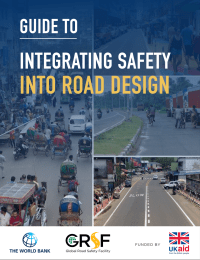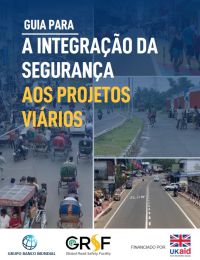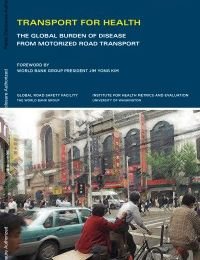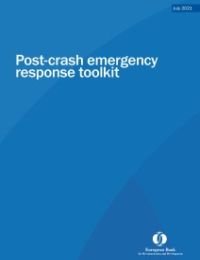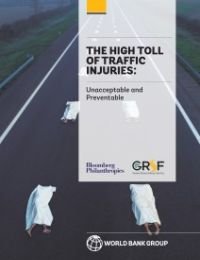Publications
1-7 of 7
-
Post-Crash Health Care
Beyond the Numbers: Estimating the Disability Burden of Road Traffic Injuries
November 2023
-
Road Infrastructure
Guide pour l’Intégration de la Sécurité dans la Conception des Routes (French)
July 2022
-
-
-
Post-Crash Health Care
Transport for Health: The Global Burden of Disease from Motorized Road Transport
August 2021
-
- reasons for taking action
- the main elements of post-crash response
- examples of best practice
- helpful resources.
- government departments and policymakers
- local and regional government
- emergency service managers and professionals
- paramedics and community responders
- laypeople and members of the community
- crash survivors, families, and organizations representing them.
-
-
Cutting traffic deaths and injuries by half could add 7 to 22% to GDP per capita over 24 years in select countries
-
Welfare benefits equivalent to 6 to 32% of GDP per capita could be realized over the same period if traffic deaths and injuries were halved
-
Road traffic injuries are the single largest cause of mortality and long-term disability among people aged 15-29, prime working age
-
Reducing the number of RTIs leads to long-term national income growth. This correlation is easy to establish as RTIs are the single largest cause of mortality and long-term disability among young people aged 15-29 (prime working age).
-
Significant long-term income growth—7 to 22% increase in GDP per capita over 24 years—can be achieved by halving road traffic deaths and injuries, in line with the current UN targets.
-
The study goes beyond productivity or economic gains, and highlights the broader welfare benefits associated with reducing road traffic mortality and morbidity, adding years of life free of injuries and lasting disabilities. This recognizes that GDP is an imperfect measure of social welfare, as it does not factor health benefits. The study finds welfare benefits equivalent to 6 to 32% of the national GDP can be realized from reducing road deaths and injuries by 50% over 24 years.
-
By maximizing healthy years of life, free of injuries and disabilities, actions to reduce road traffic injuries can help countries increase productivity, enhance the well-being of their populations, and build human capital—a key developmental priority for the World Bank.
-
Road safety goes beyond the transport sector, with a direct impact on public health, societies, and economies. Likewise, because road safety is an inherently cross-sectoral issue, real progress can only happen if all relevant stakeholders unite their efforts.
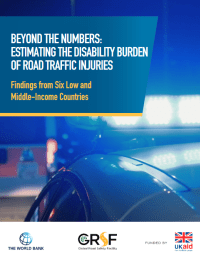
It is well-documented that road crashes claim around 1.35 million lives each year and rank as the eighth leading cause of death globally, causing huge burdens for economies, health systems, and transport networks. However, beneath the sobering fatality statistics lies a largely unexplored landscape: the staggering toll of disabilities induced by road crashes. Until now, the focus of road safety research and policy discourse has predominantly revolved around fatalities, which has limited our understanding of traffic-related injuries and disability burdens at the individual, community, and national level.
To address this critical knowledge gap, this pioneering study—involving over 2,300 patients hospitalized for road crash injuries—provides valuable insights into the prevalence, causes, and long-term impacts of crash-related disabilities. By broadening the discussion beyond fatalities to the often-overlooked issue of disability, the report paves the way for a more holistic perspective on road safety impacts, which can inform more effective road safety policies.
This report is a call to action for comprehensive and context-specific interventions that encompass both the transport and health sectors. Effective measures may include implementing safety regulations, enhancing emergency services, strengthening rehabilitative care, and expanding social safety nets to ease the financial burden on crash survivors. Collaborative efforts between governments, global and regional organizations, civil society, and other stakeholders will be indispensable.

Ce guide se concentre sur les éléments des conceptions de routes et de bordures de route sûres pour les réseaux routiers qui peuvent offrir une mobilité sûre à tous les usagers de la route.
Une réduction substantielle des décès sur les routes ne sera réalisable que si des efforts concertés sont déployés, en suivant l'approche du « Système sûr » impliquant tous les éléments de la sécurité routière, de la gestion et de la prestation. Cela inclut tous les piliers du Système sûr — à commencer par la gestion de la sécurité routière, les routes et bordures de route sûres, la vitesse sûre, les véhicules sûrs, les usagers de la route sûrs et les soins post-accident. Ce guide se concentre sur les éléments des conceptions de routes et de bordures de route sûres pour les réseaux routiers qui peuvent offrir une mobilité sûre à tous les usagers de la route, ainsi que sur les changements complémentaires pour améliorer les vitesses, la sécurité des véhicules, les comportements des usagers de la route et les soins post-accident. Une conception équilibrée des routes doit prendre en compte ces éléments complémentaires du système pour maximiser les avantages en termes de sécurité. L'énergie portée par un objet en mouvement est proportionnelle au carré de sa vitesse. Une « bordure de route indulgente » bien conçue garantit que cette énergie est dispersée en cas de collision et, par conséquent, moins d'énergie est transférée aux occupants.
La conception des infrastructures routières joue un rôle vital dans les résultats en matière de sécurité routière. Des infrastructures sûres soutiennent les autres piliers de la sécurité routière en encourageant un comportement approprié des usagers de la route (comme une vitesse appropriée et une position correcte sur la voie) et en offrant un environnement routier indulgent en cas d'erreur. Une infrastructure routière mal conçue peut entraîner des comportements dangereux des usagers de la route. Une des principales réalisations de l'approche du Système sûr est que les conducteurs font des erreurs et continueront à en faire, même si nous pouvons réduire leur fréquence. Cette erreur des usagers de la route a longtemps été reconnue comme un contributeur significatif aux mauvais résultats en matière de sécurité routière. Cependant, les routes, pour une vitesse donnée, peuvent être conçues pour réduire la probabilité de collisions, et il existe des preuves très claires que la gravité des résultats lorsque des collisions se produisent est significativement influencée par la conception de la route. Même si une collision se produit encore, une infrastructure routière améliorée peut sauver de nombreuses vies et prévenir des blessures débilitantes.
L'approche du Système sûr souligne qu'une réponse partagée est nécessaire pour aborder la sécurité routière. Cela signifie que les usagers de la route continueront à assumer la responsabilité de leurs actions, par exemple en étant vigilants et en respectant les règles de la route. Cependant, il est également reconnu que les gestionnaires et les concepteurs de routes ont une responsabilité significative de fournir un système routier qui protège tous les usagers de la route. Cela peut être réalisé grâce à des conceptions appropriées des routes.
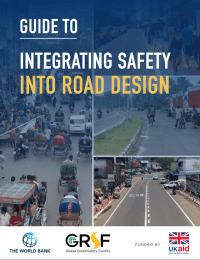
This guide focuses on elements of safe road and roadside designs for road networks that can provide safe mobility to all road users
A substantial reduction in road deaths will only be feasible if concerted efforts are made, following the “Safe System” approach involving all elements of road safety, management, and delivery. This includes all pillars of the Safe System—starting from road safety management, safe roads and roadsides, safe speed, safe vehicles, safe road users, and post-crash care. This guide focuses on elements of safe road and roadside designs for road networks that can provide safe mobility to all road users, as well as complementary changes to improve speeds, vehicle safety, road user behaviors, and post-crash care. A balanced road design must take into account these complementary system elements to maximize safety benefits. The energy carried by a moving object is proportional to the square of its speed. A well-designed “forgiving roadside” ensures that this energy is dispersed in a crash, and as a result, less energy is transferred to the occupants.
Road infrastructure design plays a vital role in road safety outcomes. Safe infrastructure supports other road safety pillars by encouraging appropriate road user behavior (such as appropriate speed and correct lane position) and by providing a forgiving road environment if things go wrong. Poorly designed road infrastructure can give rise to dangerous road user behavior. One of the key realizations of the Safe System approach is that drivers make mistakes and will continue to do so, even if we can reduce how often these occur. This road user error has long been recognized as a significant contributor to poor road safety outcomes. However, roads of any given speed can be designed to reduce the likelihood of crashes occurring, and there is very clear evidence that the severity of outcomes when crashes do occur is significantly influenced by the road design. Even if a crash still occurs, improved road infrastructure can save many lives and prevent debilitating injuries.
The Safe System approach highlights that a shared response is required to address road safety. This means that road users will continue to take responsibility for their actions, for instance by being alert and compliant with road rules. However, it is also recognized that road managers and designers have a significant responsibility to provide a road system that protects all road users. This can be achieved through appropriate designs of roads.

Este guia se concentra em elementos de projetos de estradas e acostamentos seguros para redes rodoviárias que podem fornecer mobilidade segura a todos os usuários das estradas
Uma redução substancial nas mortes nas estradas só será viável se esforços conjuntos forem feitos, seguindo a abordagem do "Sistema Seguro" envolvendo todos os elementos de segurança rodoviária, gerenciamento e entrega. Isso inclui todos os pilares do Sistema Seguro — começando pelo gerenciamento de segurança rodoviária, estradas e acostamentos seguros, velocidade segura, veículos seguros, usuários seguros das estradas e cuidados pós-acidente. Este guia se concentra em elementos de projetos de estradas e acostamentos seguros para redes rodoviárias que podem fornecer mobilidade segura a todos os usuários das estradas, bem como mudanças complementares para melhorar as velocidades, a segurança dos veículos, os comportamentos dos usuários das estradas e os cuidados pós-acidente. Um projeto rodoviário equilibrado deve levar em consideração esses elementos complementares do sistema para maximizar os benefícios de segurança. A energia transportada por um objeto em movimento é proporcional ao quadrado de sua velocidade. Um "acostamento tolerante" bem projetado garante que essa energia seja dispersada em um acidente e, como resultado, menos energia seja transferida para os ocupantes.
O projeto de infraestrutura rodoviária desempenha um papel vital nos resultados de segurança rodoviária. A infraestrutura segura dá suporte a outros pilares da segurança viária, incentivando o comportamento adequado do usuário da estrada (como velocidade adequada e posição correta na faixa) e fornecendo um ambiente de estrada tolerante se as coisas derem errado. Uma infraestrutura rodoviária mal projetada pode dar origem a um comportamento perigoso do usuário da estrada. Uma das principais conclusões da abordagem do Sistema Seguro é que os motoristas cometem erros e continuarão a fazê-lo, mesmo que possamos reduzir a frequência com que ocorrem. Esse erro do usuário da estrada é há muito reconhecido como um contribuinte significativo para resultados ruins de segurança viária. No entanto, estradas de qualquer velocidade podem ser projetadas para reduzir a probabilidade de ocorrência de acidentes, e há evidências muito claras de que a gravidade dos resultados quando os acidentes ocorrem é significativamente influenciada pelo projeto da estrada. Mesmo que um acidente ainda ocorra, uma infraestrutura rodoviária melhorada pode salvar muitas vidas e evitar ferimentos debilitantes.
A abordagem do Sistema Seguro destaca que uma resposta compartilhada é necessária para abordar a segurança viária. Isso significa que os usuários da estrada continuarão a assumir a responsabilidade por suas ações, por exemplo, estando alertas e em conformidade com as regras de trânsito. No entanto, também é reconhecido que os gerentes e projetistas de estradas têm uma responsabilidade significativa de fornecer um sistema viário que proteja todos os usuários da estrada. Isto pode ser alcançado por meio de projetos de estradas apropriados.
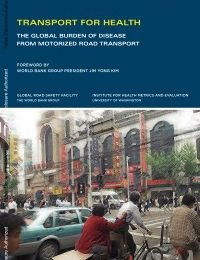
This report summarizes the findings of a long and meticulous journey of data gathering and analysis to quantify the health losses from road deaths and injuries worldwide, as part of the path-finding Global Burden of Disease (GBD) study. It is important, first, to acknowledge the profound contribution made by the lead authors and global team of injury prevention professionals to estimate the disease burden of road trauma, before absorbing their findings and recommendations. Without their dedication and tenacity, the way forward would be less certain.
The first GBD study, published nearly two decades ago, signaled an emerging road safety crisis in developing regions of the world. It triggered a remarkable program of global advocacy that culminated in the United Nations decade of action for road safety and a global plan to bring road safety outcomes under control in these regions by 2020. However, limited investment has been mobilized so far to implement the UN initiative. The second GBD studies, and related analyses presented in this report, confirm the importance of road safety as a global development priority and the urgency with which it must be addressed.
The report's findings highlight the growth in road deaths and injuries globally, and their substantial impacts on maternal and child health, despite sustained reductions over the last three to four decades in high-income countries. Combined with the deaths arising from vehicle pollution, the road transport death toll exceeds that of, for example, HIV/AIDS, tuberculosis, malaria, or diabetes. This statistic further reinforces the call for global action. Without these GBD estimates, we would not have a clear picture of the true situation because official country data in the developing world vastly understate the scale of road transport health losses.
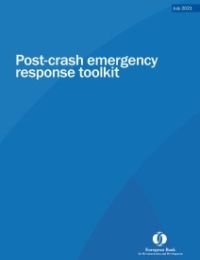
What is this toolkit?
This toolkit sets out the key elements of effective post-crash emergency response. The toolkit covers:
Who is this toolkit for?
The toolkit is for all stakeholders with an interest in post-crash response. This includes:
How to use it
The toolkit describes basic good practices for organizing an effective post-crash response. It is a starting point for dialogue and discussion, aimed at identifying goals for improving post-crash services. Every country has different structures and challenges, so the toolkit is not “one-size-fits-all.” However, certain elements of good post-crash response apply everywhere: the need for strategic planning and investment, good coordination, communication, equipment, and training.
To learn more about this project, click here.
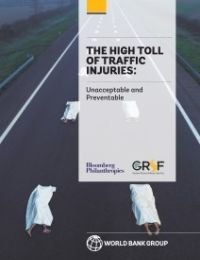
Key Findings ⌵︎
Each year, 1.25 million people lose their lives on the world’s roads and another 20 to 50 million are seriously injured. The tragic loss from a road traffic death or serious injury is compounded by the harm to households and social networks. A disproportionate 90% of road traffic injuries (RTIs) occur in low- and middle-income countries (LMICs), representing a major public health and economic burden. This is an eminently preventable problem that is critical to the development agenda. Unfortunately, due to lack of solid data, the impact of road injuries on economic growth and social welfare has been difficult to assess.
A new World Bank report funded by Bloomberg Philanthropies, The High Toll of Traffic Injuries: Unacceptable and Preventable, looks to fill the gap. It proposes a comprehensive methodology to quantify both the income growth and social welfare benefits that safer roads could bring to developing countries. The analysis is based on data collected from 135 countries over 24 years, and focuses on China, India, the Philippines, Tanzania, and Thailand—five geographically, demographically and economically diverse LMICs.
The study shows that reducing the number of RTIs in developing countries not only increases income growth, but also generates substantial welfare benefits to societies.
Key findings from the report include:
> Press Release: Road Deaths and Injuries Hold Back Economic Growth in Developing Countries

